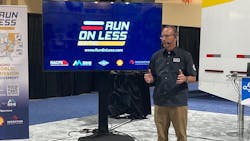NACFE Run on Less fleets lead the electric charge
LONG BEACH, California — Early fleet adopters of electric vehicles (EVs) are influencing how zero-emission vehicles and charging infrastructure will evolve in the future. Those early adopters are also finding the best total cost of ownership in urban medium-duty electric vans and trucks, terminal tractors, and short regional haul applications.
Those findings, presented during ACT Expo 2021, come from the Run on Less—Electric collaboration between the North American Council for Freight Efficiency (NACFE) and Rocky Mountain Institute (RMI).
As part of the RoL-E program, more than a dozen different electric trucks from companies such as Frito-Lay, Anheuser Busch, Penske, and DHL will be measured over the next three weeks along their usual delivery routes to tally the amount of carbon they emit.
This year marks the third Run on Less program for NACFE, but it is the first time that all trucks participating in the event are powered by electric motors. For this program, 13 participating fleets and their trucks are in four different market segments.
“Many applications are available now for electric trucks,” explained Mike Roeth, NACFE executive director, during ACT Expo. “These include vans and step vans, box trucks, terminal tractors, and regional or short-haul tractors. Some improvements in weight range and infrastructure are needed for additional routes.”
NACFE and RMI will collect data along the three-week run and stream it live. Metrics will begin streaming from each truck starting Thursday, Sept. 2, and results will be unveiled the week of Sept. 20.
“The transition to electric trucks is happening in the trucking industry all over North America,” Roeth said. “Our preliminary findings based on early adopters show that switching from a gasoline or diesel-powered vehicle to an electric one is affordable. And there is now inertia in the trucking industry that will speed up adoption in coming years.”
Interviews with truck drivers, fleet operators, and delivery companies prior to the run’s launch found additional insights:
- EV adoption is occurring throughout North America, but for longer haul, heavy-duty semi-trucks use has been somewhat limited to California.
- There are benefits to EVs (quiet operation and reliability) as well as challenges (infrastructure and range).
- EV truck ecosystem inertia is in its early stages with many solutions emerging that will support adoption in the next several years.
- The industry needs to develop standards in the areas of charging, repair, maintenance, and training.
- There is a huge demand for real-world information on EVs in commercial applications and on charging infrastructure.
- The mix of startups and traditional truck OEMs and component manufacturers is expediting the development of creative and practical solutions.
- More thought is needed on the best way to gather and manage the necessary data for fleets and manufacturers to measure and monitor their EVs.
- EVs present operational challenges, for example longer charging times than fueling, which these fleets are working to mitigate.
- Overall, NACFE spoke with more than 90 people delivering real freight within this year’s program.
“We talked to the operations people—the truck drivers and fleet managers—and sometimes when it comes to new technologies, they might not be the most accepting,” Roeth said. “They have beer to haul, packages to deliver, and all that work to do. For me, the big surprise was how excited they are about these trucks.”
Jessie Lund, senior associate with RMI’s Carbon-Free Mobility program, said another surprise was around charging infrastructure and the timelines that some of the participating fleets had to wait on utilities in order to secure the infrastructure they needed.
“I think that is certainly an opportunity for improvement moving forward,” Lund said.
All 13 fleets participating in the run are charging their vehicles at their own depots. In addition, NACFE and RMI held an Electric Truck Bootcamp series, which featured 48 experts and had about 1,500 participants who took part in person or by viewing each of the 10 training sessions.
Check out the drivers, truck manufacturers, and fleets participating in this year’s Run on Less:
- Rene Solis—driving a BYD tractor for Anheuser-Busch
- Joseph Villaneuva—driving a Cummins box truck for Frito-Lay
- Donald Disesa—driving a Freightliner eCascadia for Penske
- Jazmin Vasquez—driving a Kalmar Ottawa electric terminal tractor for NFI
- Antonio Grimila—driving a Lightning eMotors van for DHL
- Francis Lajoie—driving a Lion6 electric truck for Day & Ross
- Ray Hancock—driving a Lonestar Specialty Vehicles terminal tractor for Ryder
- Alexander Schaumann—driving a Motiv-Powered step van for Purolator
- Conrad Hanson—driving an Orange EV terminal tractor for Ruan
- Pat Brandon—driving a Peterbilt 579EV for Biagi Bros.
- Michael Johnson—driving a Roush CleanTech truck for Roush Fenway Racing
- Jeffrey Howard—driving a Volvo electric VNR for NFI
- Stephen Garrett—driving a Workhorse C1000 for Servall Electric
About the Author

Cristina Commendatore
Cristina Commendatore is a past FleetOwner editor-in-chief. She wrote for the publication from 2015 to 2023.
